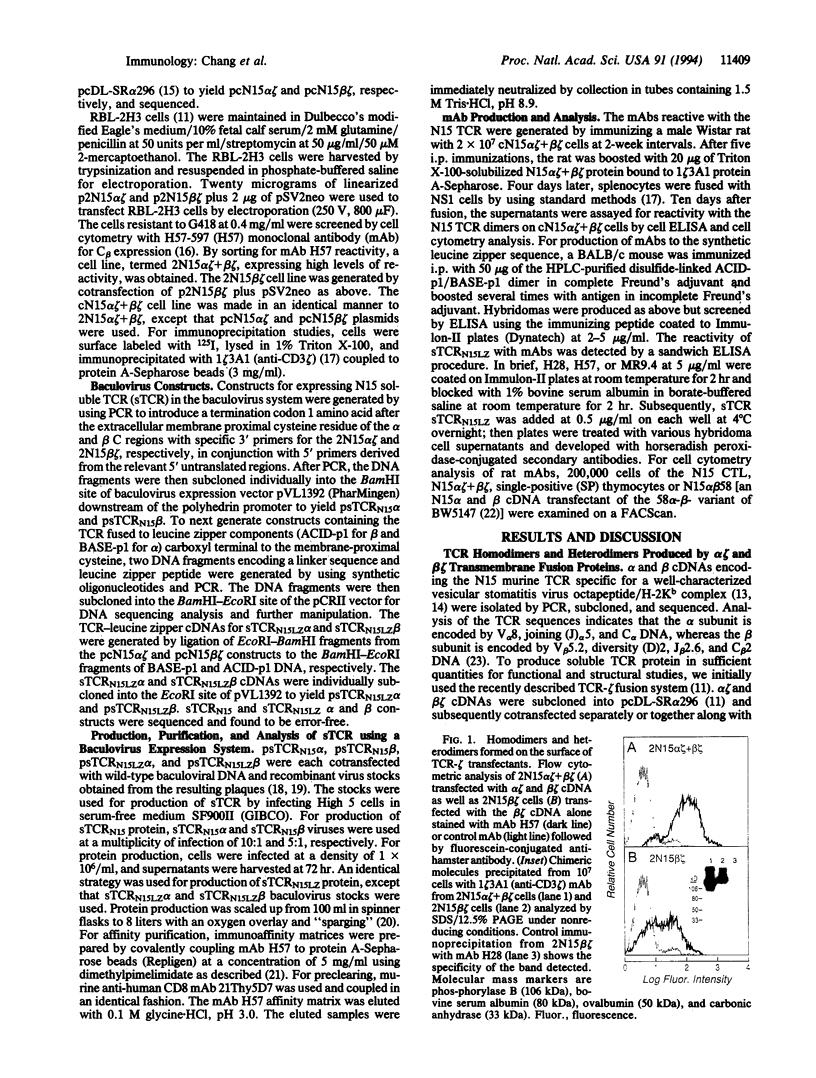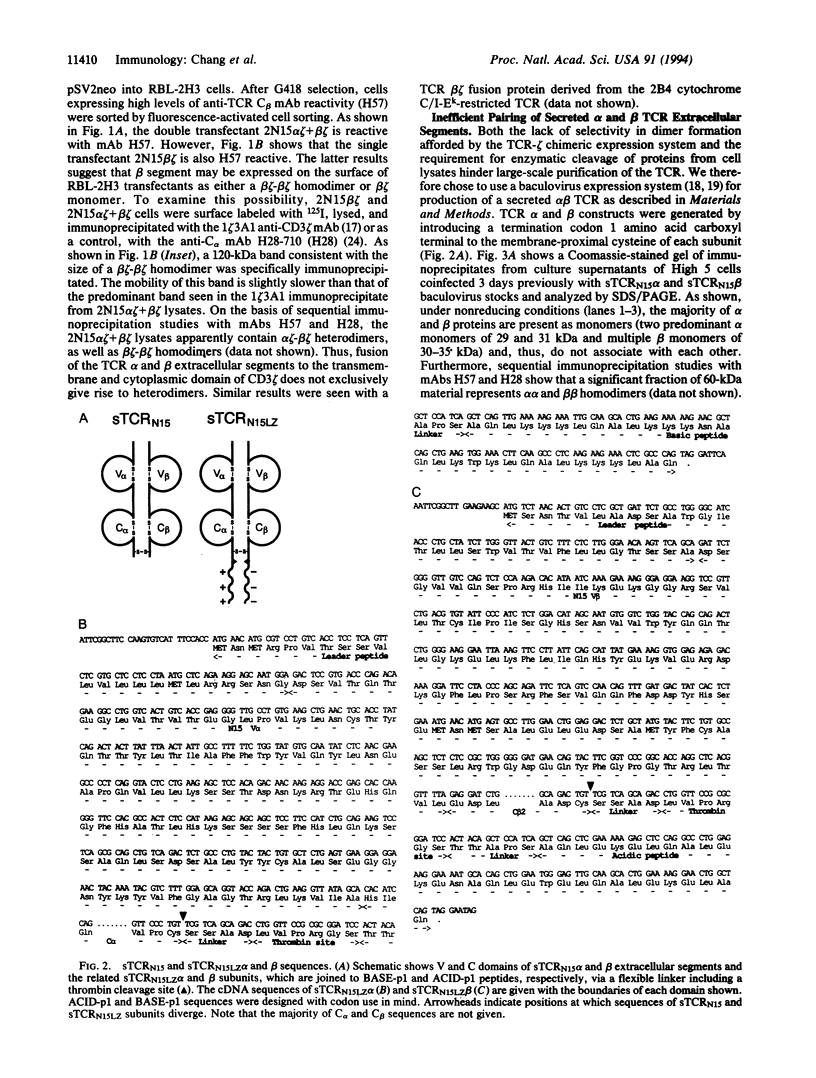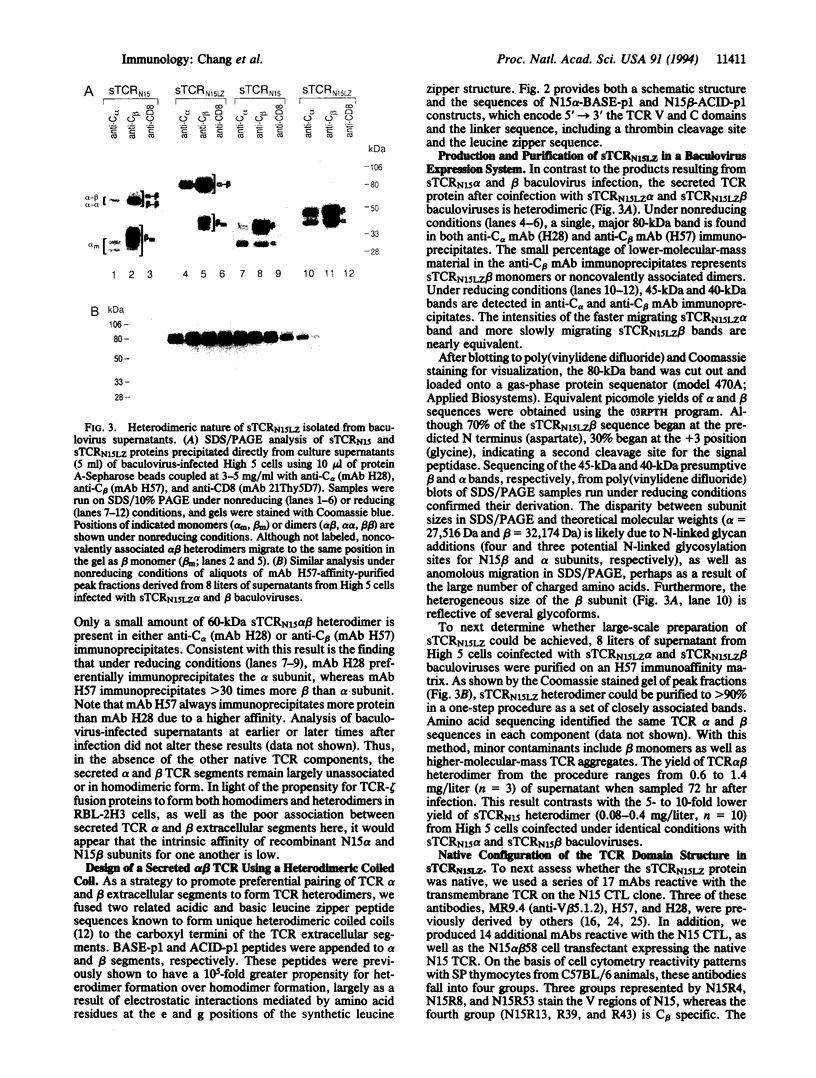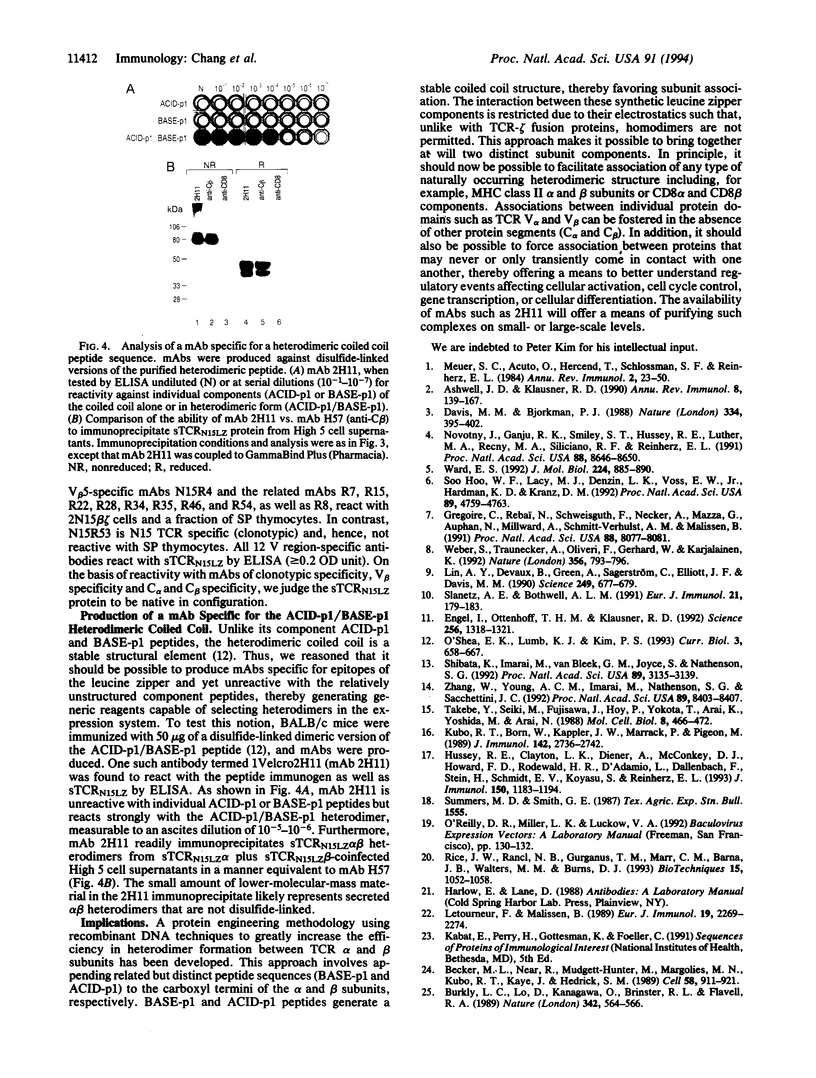Abstract
Generation of soluble T-cell receptor (TCR) molecules by a variety of genetic engineering methods has been hampered by inefficient pairing of alpha and beta subunits in the absence of their respective transmembrane regions and associated CD3 components. To overcome this obstacle, we have added 30-amino acid-long segments to the carboxyl termini of alpha and beta extracellular domains via a cleavable flexible linker. These peptide segments (BASE-p1 for alpha and ACID-p1 for beta) have been previously shown to selectively associate to form a stable heterodimeric coiled coil termed a leucine zipper. Homodimeric structures are not permitted due to electrostatic repulsion among amino acid side chains. Expression of a representative TCR-leucine zipper fusion protein in a baculovirus expression system results in production of alpha beta TCR heterodimer at 0.6-1.4 mg/liter. This yield is 5- to 10-fold greater than that of the TCR expressed in the absence of the synthetic leucine zipper sequence. The structure of the TCR component of the fusion heterodimer was judged to be native when probed with a panel of 17 mAbs specific for alpha and beta constant and variable domains. A mAb specific for the isolated BASE-p1/ACID-p1 coiled coil was also generated and shown to react with the TCR fusion protein. The above technology should be broadly useful in the efficient production and purification of TCRs as well as other heterodimeric proteins.
Full text
PDF




Images in this article
Selected References
These references are in PubMed. This may not be the complete list of references from this article.
- Ashwell J. D., Klusner R. D. Genetic and mutational analysis of the T-cell antigen receptor. Annu Rev Immunol. 1990;8:139–167. doi: 10.1146/annurev.iy.08.040190.001035. [DOI] [PubMed] [Google Scholar]
- Becker M. L., Near R., Mudgett-Hunter M., Margolies M. N., Kubo R. T., Kaye J., Hedrick S. M. Expression of a hybrid immunoglobulin-T cell receptor protein in transgenic mice. Cell. 1989 Sep 8;58(5):911–921. doi: 10.1016/0092-8674(89)90943-4. [DOI] [PubMed] [Google Scholar]
- Burkly L. C., Lo D., Kanagawa O., Brinster R. L., Flavell R. A. T-cell tolerance by clonal anergy in transgenic mice with nonlymphoid expression of MHC class II I-E. Nature. 1989 Nov 30;342(6249):564–566. doi: 10.1038/342564a0. [DOI] [PubMed] [Google Scholar]
- Davis M. M., Bjorkman P. J. T-cell antigen receptor genes and T-cell recognition. Nature. 1988 Aug 4;334(6181):395–402. doi: 10.1038/334395a0. [DOI] [PubMed] [Google Scholar]
- Engel I., Ottenhoff T. H., Klausner R. D. High-efficiency expression and solubilization of functional T cell antigen receptor heterodimers. Science. 1992 May 29;256(5061):1318–1321. doi: 10.1126/science.1598575. [DOI] [PubMed] [Google Scholar]
- Grégoire C., Rebaï N., Schweisguth F., Necker A., Mazza G., Auphan N., Millward A., Schmitt-Verhulst A. M., Malissen B. Engineered secreted T-cell receptor alpha beta heterodimers. Proc Natl Acad Sci U S A. 1991 Sep 15;88(18):8077–8081. doi: 10.1073/pnas.88.18.8077. [DOI] [PMC free article] [PubMed] [Google Scholar]
- Hoo W. F., Lacy M. J., Denzin L. K., Voss E. W., Jr, Hardman K. D., Kranz D. M. Characterization of a single-chain T-cell receptor expressed in Escherichia coli. Proc Natl Acad Sci U S A. 1992 May 15;89(10):4759–4763. doi: 10.1073/pnas.89.10.4759. [DOI] [PMC free article] [PubMed] [Google Scholar]
- Hussey R. E., Clayton L. K., Diener A., McConkey D. J., Howard F. D., Rodewald H. R., D'Adamio L., Dallenbach F., Stein H., Schmidt E. V. Overexpression of CD3 eta during thymic development does not alter the negative selection process. J Immunol. 1993 Feb 15;150(4):1183–1194. [PubMed] [Google Scholar]
- Kubo R. T., Born W., Kappler J. W., Marrack P., Pigeon M. Characterization of a monoclonal antibody which detects all murine alpha beta T cell receptors. J Immunol. 1989 Apr 15;142(8):2736–2742. [PubMed] [Google Scholar]
- Letourneur F., Malissen B. Derivation of a T cell hybridoma variant deprived of functional T cell receptor alpha and beta chain transcripts reveals a nonfunctional alpha-mRNA of BW5147 origin. Eur J Immunol. 1989 Dec;19(12):2269–2274. doi: 10.1002/eji.1830191214. [DOI] [PubMed] [Google Scholar]
- Lin A. Y., Devaux B., Green A., Sagerström C., Elliott J. F., Davis M. M. Expression of T cell antigen receptor heterodimers in a lipid-linked form. Science. 1990 Aug 10;249(4969):677–679. doi: 10.1126/science.1696397. [DOI] [PubMed] [Google Scholar]
- Meuer S. C., Acuto O., Hercend T., Schlossman S. F., Reinherz E. L. The human T-cell receptor. Annu Rev Immunol. 1984;2:23–50. doi: 10.1146/annurev.iy.02.040184.000323. [DOI] [PubMed] [Google Scholar]
- Novotny J., Ganju R. K., Smiley S. T., Hussey R. E., Luther M. A., Recny M. A., Siliciano R. F., Reinherz E. L. A soluble, single-chain T-cell receptor fragment endowed with antigen-combining properties. Proc Natl Acad Sci U S A. 1991 Oct 1;88(19):8646–8650. doi: 10.1073/pnas.88.19.8646. [DOI] [PMC free article] [PubMed] [Google Scholar]
- O'Shea E. K., Lumb K. J., Kim P. S. Peptide 'Velcro': design of a heterodimeric coiled coil. Curr Biol. 1993 Oct 1;3(10):658–667. doi: 10.1016/0960-9822(93)90063-t. [DOI] [PubMed] [Google Scholar]
- Rice J. W., Rankl N. B., Gurganus T. M., Marr C. M., Barna J. B., Walters M. M., Burns D. J. A comparison of large-scale Sf9 insect cell growth and protein production: stirred vessel vs. airlift. Biotechniques. 1993 Dec;15(6):1052–1059. [PubMed] [Google Scholar]
- Shibata K., Imarai M., van Bleek G. M., Joyce S., Nathenson S. G. Vesicular stomatitis virus antigenic octapeptide N52-59 is anchored into the groove of the H-2Kb molecule by the side chains of three amino acids and the main-chain atoms of the amino terminus. Proc Natl Acad Sci U S A. 1992 Apr 1;89(7):3135–3139. doi: 10.1073/pnas.89.7.3135. [DOI] [PMC free article] [PubMed] [Google Scholar]
- Slanetz A. E., Bothwell A. L. Heterodimeric, disulfide-linked alpha/beta T cell receptors in solution. Eur J Immunol. 1991 Jan;21(1):179–183. doi: 10.1002/eji.1830210127. [DOI] [PubMed] [Google Scholar]
- Takebe Y., Seiki M., Fujisawa J., Hoy P., Yokota K., Arai K., Yoshida M., Arai N. SR alpha promoter: an efficient and versatile mammalian cDNA expression system composed of the simian virus 40 early promoter and the R-U5 segment of human T-cell leukemia virus type 1 long terminal repeat. Mol Cell Biol. 1988 Jan;8(1):466–472. doi: 10.1128/mcb.8.1.466. [DOI] [PMC free article] [PubMed] [Google Scholar]
- Ward E. S. Secretion of T cell receptor fragments from recombinant Escherichia coli cells. J Mol Biol. 1992 Apr 20;224(4):885–890. doi: 10.1016/0022-2836(92)90455-s. [DOI] [PubMed] [Google Scholar]
- Weber S., Traunecker A., Oliveri F., Gerhard W., Karjalainen K. Specific low-affinity recognition of major histocompatibility complex plus peptide by soluble T-cell receptor. Nature. 1992 Apr 30;356(6372):793–796. doi: 10.1038/356793a0. [DOI] [PubMed] [Google Scholar]
- Zhang W., Young A. C., Imarai M., Nathenson S. G., Sacchettini J. C. Crystal structure of the major histocompatibility complex class I H-2Kb molecule containing a single viral peptide: implications for peptide binding and T-cell receptor recognition. Proc Natl Acad Sci U S A. 1992 Sep 1;89(17):8403–8407. doi: 10.1073/pnas.89.17.8403. [DOI] [PMC free article] [PubMed] [Google Scholar]





